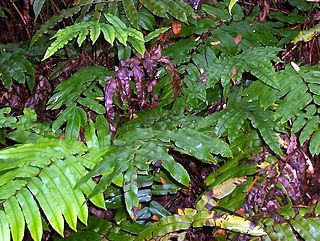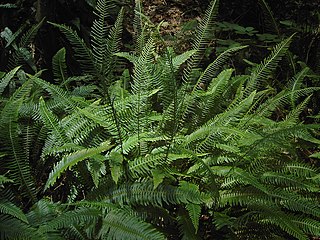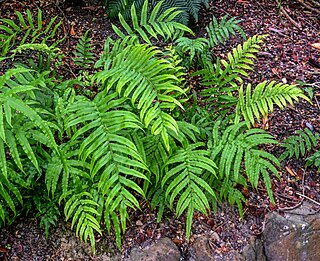
Onoclea is a genus of plants in the family Onocleaceae, native to moist habitats in eastern Asia and eastern North America. They are deciduous ferns with sterile fronds arising from creeping rhizomes in spring, dying down at first frost. Fertile fronds appear in late summer. Depending on the authority, the genus contains one to five species.

Blechnaceae is a family of ferns in the order Polypodiales, with a cosmopolitan distribution. Its status as a family and the number of genera included have both varied considerably. In the Pteridophyte Phylogeny Group classification of 2016, the family has 24 genera, and excludes genera placed in the separate family Onocleaceae. The family is divided into three subfamilies, including Blechnoideae s.s. Alternatively, the entire family may be treated as the subfamily Blechnoideae s.l. of a very broadly defined family Aspleniaceae, and include genera others place in Onocleaceae.

Lomaria is a genus of ferns belonging to the family Blechnaceae.
Anthurium sulcatum is a species of plant in the family Araceae. It is endemic to Ecuador, and became known to the scientific community when Luis Sodiro collected a type in the Pchincha province in 1882. A collection of the species was housed in the Berlin herbarium, which was destroyed during the Second World War. Its natural habitat is subtropical or tropical moist lowland forests. It is threatened by habitat loss.
Lomaridium dendrophilum, synonym Blechnum dendrophilum, is a species of fern in the family Blechnaceae. It is endemic to Ecuador and known only from Napo Province and Pichincha Province. It was first described by Luis Sodiro in the late 19th century. Although there are no known conservation measures, it has been recorded from Illinizas Ecological Reserve.
Parablechnum monomorphum, synonym Blechnum monomorphum is a species of fern in the family Blechnaceae. It is native to Colombia (Antioquia), Ecuador and Bolivia.
Blechnum petiolare is a species of fern in the family Blechnaceae. It is endemic to Ecuador and known only from Bolívar Province. When it was first described in the early 20th century, it was known from Chillanes but this area has been heavily disturbed and the species continues to be threatened.
Austroblechnum divergens, synonyms including Blechnum divergens, Blechnum rimbachii and Blechnum floresii, is a species of fern in the family Blechnaceae.
Amauropelta aculeata, synonym Thelypteris aculeata, is a species of fern in the family Thelypteridaceae. It is endemic to Ecuador. Its natural habitat is subtropical or tropical moist montane forests. It is threatened by habitat loss.
Amauropelta bonapartii, synonym Thelypteris bonapartii, is a species of fern in the family Thelypteridaceae. It is endemic to Ecuador. Its natural habitat is subtropical or tropical moist montane forests. It is threatened by habitat loss.
Amauropelta conformis, synonym Thelypteris conformis, is a species of fern in the family Thelypteridaceae. It is endemic to Ecuador. Its natural habitat is subtropical or tropical moist montane forests. It is threatened by habitat loss.
Amauropelta macra, synonym Thelypteris macra, is a species of fern in the family Thelypteridaceae. It is endemic to Ecuador. Its natural habitat is subtropical or tropical moist montane forests. It is threatened by habitat loss.
Zygophlebia eminens is a species of grammitid fern. It is endemic to Ecuador. Its natural habitats are subtropical or tropical moist montane forests and subtropical or tropical high-altitude grassland. It is threatened by habitat loss. Its veins are more regularly free than any other Zygophlebia species besides Zygophlebia dudleyi, though some veins may be forked or fused.

Parablechnum wattsii, synonym Blechnum wattsii, is a common terrestrial fern growing in rainforest and open forest. It is often seen near creeks in much of south eastern Australia, including Victoria, Tasmania, South Australia, New South Wales and Queensland. The specific epithet wattsii honours William Walter Watts (1856-1920). Watts was considered an authority on mosses and ferns and has more than 30 species named for him. Common names by which the species may be called are hard water fern - from its stiff leathery fronds, leech fern - as forest workers often encounter leaches while working in clusters of these ferns, hard hill fern - from the fern's habit and habitat, and red cabbage fern - from the bronze-pink colour of the young fronds resembling cooked red cabbage.

Struthiopteris is a genus of ferns belonging to the family Blechnaceae, subfamily Blechnoideae.

Parablechnum minus, synonym Blechnum minus, is a small fern growing in moist situations in a variety of habitats in eastern Australia. It is often seen by streams.

Parablechnum howeanum, synonym Blechnum howeanum, is a fern in the family Blechnaceae. The specific epithet refers to the locality to which it is endemic.

Parablechnum gregsonii, synonym Blechnum gregsonii, is a type of fern, mostly seen in the Illawarra and Blue Mountains areas of eastern Australia, often near waterfalls and moist gullies.

Parablechnum is a genus of ferns in the family Blechnaceae, subfamily Blechnoideae, according to the Pteridophyte Phylogeny Group classification of 2016. The genus is accepted in a 2016 classification of the family Blechnaceae, but other sources sink it into a very broadly defined Blechnum, equivalent to the whole of the PPG I subfamily.









